I brought my hinoki to a Bay Island Bonsai workshop last weekend. It was the first time I’d thought much about the tree since I worked on it last year. It had filled in quite a bit and I wanted to give it some attention. I also had yet to decide what tree I’d be showing at BIB’s upcoming exhibit in January. Boon and I looked at the tree briefly and figured it was close enough to ready for exhibit. As is so often the case, I’d prefer wait a few more years before showing the tree again, but decided, ultimately, that it would be fun to show it at next year’s exhibit and then again in two years when it’s further along.
I first showed the tree at BIB’s inaugural exhibit in 2000. Every few years I remove the lowest branches and re-style the remaining foliage. Between exhibits, the tree has a chance to fill in a bit. To keep the tree full for next January’s exhibit, I don’t want to remove much foliage. For this workshop, I simply removed the yellow and brown foliage and started thinking about the tree’s silhouette.
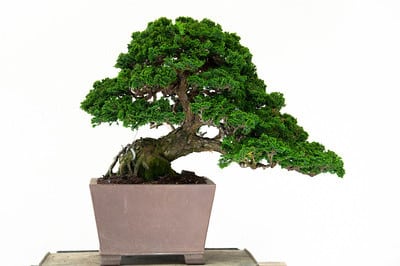
Hinoki (12″/30.5cm) – summer 2011
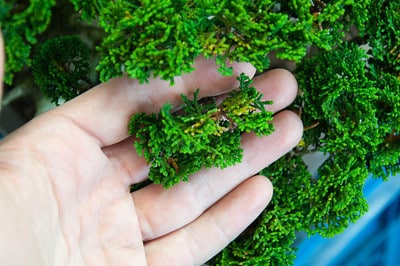
Old and new foliage
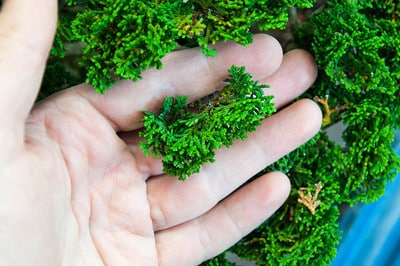
Old foliage removed
Cleaning up the old foliage made it clear that the tree was full enough to show. But what struck me, is the direction of the tree.
I asked others in the workshop what they thought. Some suggested the tree points to the right. I think the lowest branch on the right does point to the right, and I desire for the tree to point right. I’d argue, however, that the apex points decidedly to the left. To create balance, the key branch must point in the same direction as the apex. This tree is close to balanced, but not quite there yet.
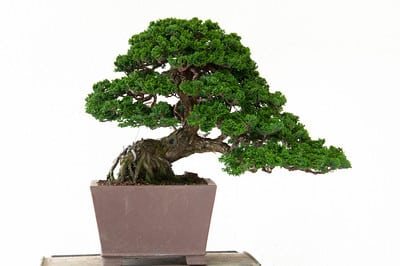
Hinoki – which way does it go?
I noticed, as I looked closely at the tree, that as I rotate it to the right, the direction of the apex shifts from left to right.
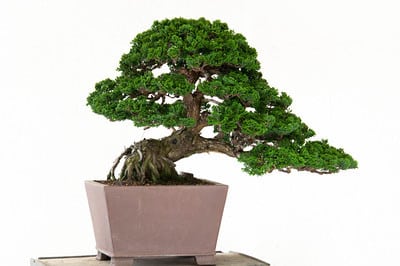
Apex left, key branch right
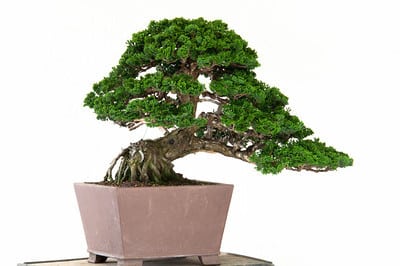
Neutral
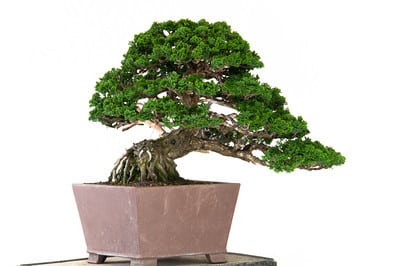
Apex beginning to point to the right
Although the tree’s silhouette looks pretty good from this angle, it’s not a suitable front for the tree as the key branch points away from the viewer. The photo is useful, however, because it suggests to me how to style the branches and apex to create balance.
Do all of these shots look the same? Are some angles more interesting than others? Am I being picky? Good questions! I’m hoping to re-set the branches before exhibit to improve the tree’s balance. Not all of the tree’s branches are long enough for me to create the silhouette I’m looking for, but I can get closer to my ideal ahead of the exhibit. Time for more wiring!
8/29/2011 update – see virtual by Michael Pollock on Flickr.
Subscribe to Bonsai Tonight
New Posts Delivered Every Tuesday and Friday
Daniel Dolan says
Jonas:
Beautiful Hinoki….what variation, nan gracilis or other?
Would like to know the size….approximate pot dimension for scale?
Lastly, related to composition but not specifically the apex. The Midwest Bonsai Society recently hosted Ryan Neil as our Visiting Judge and during our workshop he addressed the concern of main branched or trunks that are parallel or perpendicular to the edge of the pot. [I don’t think he meant formal uprights]
The comment was that this attracts our eye to that feature. Further, he commented that in a high quality Bonsai the eye is never to be attracted to just one feature….something I was not aware of previously.
I observed that the central portion of your tree’s trunk is essentially vertical. in some of the views ….less in the top photo where it suggests slight movement to the left. I barely know what I am talking about but interested to know your comments and the attitude of BIB regarding this comment by Ryan Neil.
Best regards,
D/D
xwires says
Hi Dan – the tree is 12″ from the top of the pot; the pot is 9″ across at the top. I think it’s a chamaecyparis obtusa nana.
Orthogonal lines don’t come to mind when I think about bonsai in the abstract – not like asymmetrical triangles do. I can add that I appreciate trees with prominent features more easily than I can trees with distracting features. The trunk on this hinoki actually curves a bit to the left – something I’ll have to downplay when I prepare the tree for exhibit. I find it distracting that the apex points left and the key branch – the first on the right in this case – points right. But the big question concerns the existence of a BIB attitude. I’d never stopped to think about this, but upon reflection, I believe one could argue for its existence. In general, Ryan’s comments sound good to me – thanks for the note!
bonsaijapan says
Hi Jonas,
I think what becomes immediately apparent when you compare the original front with the proposed fronts is the foliage outline.
It is so hard to tell from pictures which of the fronts is best, but what is clear to see is the different outlines the foliage takes on in the various fronts.
The original front has a smooth and continuous outline whereas the other options have more of a dynamic jaggered or stepped outline. If you do keep the original front i would be aiming to shape the outline to reflect this more dynamic silhouette. Some branches short others a little longer. Its a small tweek but i think it would make quite a difference.
Its a really nice Hinoki, and i cant wait to see how you style it.
Daniel Dolan says
Jonas:
Thanks for your reply….I was a bit unclear. Ryan’s comment was that perpendicular and parallel features are to be avoided….as they immediately focus the eye rather than on the overall view.
Question for you or Boon….a prominent Master in the United States explained to me that the Japanese term “Mekaki” was the process of letting trees grow all spring and summer without pinching or pruning to gain strength or build structure. Bonsai today in Volume 42 page 35 defines Mekaki as something else….”the selective pinching of new shoots”……was wondering if you know or could ask any of the Japanese folks in your group….what does this term refer to?
Thanks much,
Regards,
D/D
xwires says
@ Daniel – that’s a good question, I’m not familiar with the term – another reader might know more about it. Letting trees grow all season is an important concept, as is the selective pinching of new shoots – I practice both, but don’t know the Japanese terms. And I agree about perpendicular and parallel features – like so many other features, they can be distracting and detract from a tree’s overall appearance.
@Joe – you caught exactly what I was trying to show in the silhouette. My goal for improving the outline is just as you described. Easier said than done! Thanks for the note.
Chris says
Hi, i was first put on to your web sight by Ron Smith and I have been following for a few years now and have to compliment you on the website.
I like the tree after you turned it more, the nebari seems more balanced and the branch placement seems to meld well with the trunk. Why not bend the branch to a more forward position? Or at least the end of it so the pad takes a more forward position even if the branches main element is directed to the back?
xwires says
Thanks Chris – I like the characteristics you mention as well: the nebari and silhouette are great from the most rotated angle. The trunk, however, points toward the back from this front, a characteristic that doesn’t show well in the photo. I may have some leeway for changing the front, but can’t go too far without sacrificing the angle of the trunk. I’ll see what I can do when I get to work.
Zack Clayton says
One other thing I notice in the most rotated photo, the foliage pads are starting to sow up as distinct masses. I think this improves the depth of the composition. It would be interesting to see this in the original front as you wire and pinch. Is it possible to rotate the trunk/branches counterclockwise in the upper third of the tree to shift the apex?
Boon says
Hi Daniel,
the comment you posted
“parallel or perpendicular to the edge of the pot” it should be the trunk line of the tree (except formal upright). for the branches, you can check Kimura book or article. there are several trees that he style, the branches are parallel to the pot or horizontal.
for the work Mekaki- it mean thining new shoots to 2 shoots -ie black pine after decandle, strong trees will send out several buds and those buds will grow into new shoots. in fall we will thin the summer growth to 2 shoots.
Michael Pollock says
I agree that the crown is currently flowing right to left (against all of the elements in the lower part of the tree).
I learned this most clearly from Michele Andolfo a few years ago when he was the guest of the MidAtlantic Bonsai Societies. It is a bit hard to express verbally, but I’ll try. The easiest way to remedy this is with some wire. If some space is opened in the right side of the crown, the right side will no longer have a longer, uninterrupted line of foliage. I would also wire down, or prune, a bit from the upper left.
Here is a virtual I whipped up to hopefully make this a bit clearer.
xwires says
@Michael – the virtual you whipped up looks great, thanks! Opening up the line of foliage on the right and reducing the foliage on the upper left are exactly what I had in mind.
@Zack – good question, I hadn’t thought of rotating or radically bending the upper part of the trunk. It’s likely possible. I’ll try to achieve the effect you describe by wiring the branch pads for the upcoming exhibit, and if that doesn’t work, I’ll look into the more radical approaches next year.
All of the feedback I’ve received about this tree has been great – thanks to all of you!
Chris Pogliano says
Good point with the trunk angle. Sorry, I missed that in the photo.
I liked Boon’s comment on Mekaki. The idea someone had earlier of it being a situation of letting the growth go a little, though it sounds like it was a little off (admitting once again that they were closer then me to the meaning) brings up a question for me. I know some individuals in Japan will let the growth on trees become very dense and let the ends of twigs go without producing much for ramification. I have even seen this from time to time on kokufu books as well. Is this a styling difference among artists or is it a technique on refined trees to slow growth by letting the twigs get over crowded? I remember from school that letting twigs get over crowded, it can slow growth be having the different twigs compete for the same amount of light but they also said it will increase disease and insect problems because light, wind and insecticides have a harder time getting in. This one has been bothering me for months now and I can’t figure out the reason.
xwires says
Good question Chris. I’m not familiar with techniques to keep trees dense in order to slow growth. I usually think of it the other way around – density is the goal, and slower growth sometimes results from density. Dense trees are, as you point out, more susceptible to disease and infestation than less-dense trees, but they look great in exhibits. The trick is to balance density with ramification and health. Without ramification, we can’t cut back bonsai and the trees slowly get bigger and bigger.
When to pinch is a related question. As soon as I have a tree mature enough to warrant seasonal pinching – or whenever I see such a tree in workshop – I’ll be sure to post some pics. Thanks for the note!
Chris Pogliano says
Thank you for for sharing your observations. Maybe it is just an opinion thing on my part then, what may look to dense for me is just right for someone else then. All good. I am really looking forward to any pictures you might find so I can further refine my understanding of how dense to grow foliage pads.
Thank you again and keep up the good work of sharing your journey with bonsai.